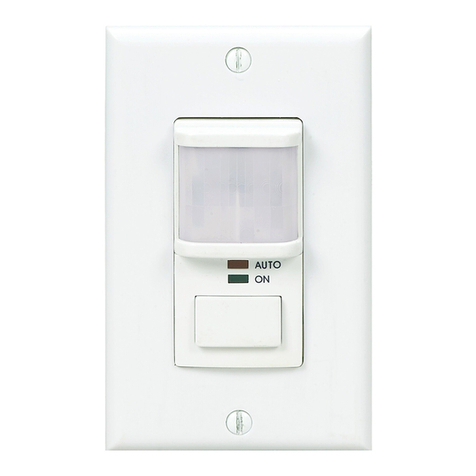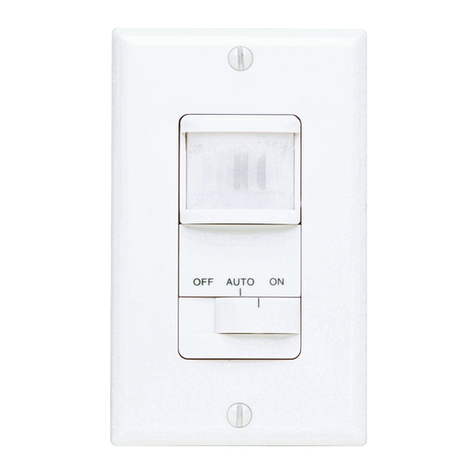6107
Interruptor
Tridireccional de
pared y Dectector de
Movimiento
El interruptor de pared y detector de movimiento 6107 detecta mov-
imiento y prende la luz por un período de tiempo ajustable. Se
puede programar la fotocélula incorporada para que mantenga la luz
apagada cuando no se la necesita. La unidad goza de una excelente
sensibilidad y de un gran alcance de detección de 150°. Se la puede
usar con una luz incandescente o con una fluorescente que se prenda
rápido.(No use con balastro electrónico)
El 6107 también puede usarse como reemplazo de un interruptor de 3
vÌas o uno unipolar. Algunas códigos requieren que la instalación sea
hecha por un electrista calificado.
Sus características incluyen:
• Angulo de detección de movimiento de 150°.
• “On time” (duración) ajustable de 5 Seg. a 20 Minutos.
• Fotocélula ajustable.
• Funciona con luces incandescentes y fluorescentes de encendido
instantáneo. (Pero no con balastros electrónicos)
• Funciona con motores de hasta 1/6 hp (caballo de fuerza).
• Deslice el interruptor selector a la fase de OFF, ON y AUTO.
ADVERTENCIA: Apague la energía en el cortacircuitos antes de hacer las conexiones.
Nota: un circuito "tridireccional" es un circuito de luz
controlado desade dos interruptores separados. Si
desea usar este producto con un circuito de un solo
interruptor vea la página 6.
• Quite la placa cubertora decorativa (asegurada con
dos tornillos decorativos).
• Para quitar la cublerta del control. (Presione con un
destornillador. Gire la tapa para quitarla para tener
acceso al tornillo de adjuste.)
• Elija el interruptor que va a reemplazar y remuévalo.
• Para facilitar la instalación y el cableado más tarde,
use cinta eléctrica en los cables y marque do dónde
viene cada uno.
• No conecte al alambre neutro o la unidad se dañará
y perderá la garantía.
• Conecte el Interruptor de Detector de Movimiento 6107 como se muesta en el diagrama de abajo:
• Monte el 6107 dentro de la caja de empalme con los tornillos para la caja de empalme.
• Prenda la energía en el cortacircuitos.
• Prefije los controles: Tiempo Minutos, Ajuste de foto completamente hacia la derecha. Cubra el lente con una
cinta protectora.
• Con el detector de movimiento en posición de prendido (ON) prenda y apague el control remoto varias veces.
Vaya al paso 1, 2 ó 3 dependiendo de los resultados.
ADVERTENCIA: Apague la energia en el cortacircuitos antes de hacer las conexiónes.
Si tiene problemas con su interruptor de pared siga esta guía. Si el problema persiste, llamar a servicios del
consumidor 1-866-853-4293 8:00 AM a 7:00 PM Hora del este, Dias Laborables.
Entrada eléctrica........................................................................................................................120V, 60 Hz.
Carga Fluorescente (No use con balastro electrónico)...(2) 30 Vatios Min. y 400 Vatios Máx. de prendido rápido
Carga del motor......................................................................................................................1/8 HP maximó
Incandescente........................................................................................................................500 Vatios
Duración...........................................................................Ajustable aproximadamente de 5 seg. a 20 minutos
Detector de fotocélula.............................................................................desde luz de pleno día a menos de 1FC.
Alcance................................................................................Hasta 15 pies a 150°, hasta 30 pies frente al detector
Hay 6 ajustes precalibrados para el lapso de
tiempo que las luces permanecen encendidas:
Prueba (5 segundos), 1, 5, 10, 15 y 20 minu-
tos. Use un destornillador Phillips pequeño
para regular el control de TIEMPO. Gire el
control hasta que se “coloque a presión” en la
posición de tiempo deseada.
Recoloque la tapa del panel de control e instale la placa ornamental de pared. En las instalaciones donde
se combine el interruptor detector de movimiento Cooper con otros interruptores o enchufes en una caja
extendida, se necessitará comprar una placa combinadora de pared. Varias placas combinadoras de pared
se pueden encontrar en los Centros Comerciales para el Hogar y en las Tiendas de Aparatos Eléctricos.
Deslise el interruptor unas cuantas veces para asegurarse de que esté funcionando bien.
Cuando la luz del cuarto esté al
nivel al cual usted desea que la luz
se prenda, fije el interruptor en la
posición de AUTO.
Ponga el control de TIEMPO (TIME)
en la posición de 5 segundos.
Ponga el control de LUZ (LIGHT) en
su posición de mínimo nivel (com-
pletamente hacia la izquierda).
Espere que la luz se apague.
Gire el ajuste de la LUZ (LIGHT)
hacia la derecha, con pequeños
giros, y espere por 2 segundos
antes de mover su mano por frente
del detector. Repita hasta que la
luz controlada por el detector se
prenda. La luz se prenderá cuando
el nivel de luz esté al nivel actual
o más abajo y cuando se detecte
movimiento.
Para ajustar la fotocélula:
Interruptor Selector de FASE
Mueva el interruptor para seleccionar una de las tres fases de operación:OFF, AUTO, ON
OFF: La luz permanece apagada.
AUTO: La luz se prende por el tiempo fijado cuando detecta movimiento y cuando el nivel de luz es más
bajo que el nivel fijado.
ON: La luz permanece prendida continuamente. Apagar/encender el interruptor de 3 vías no tiene efecto
alguno.
•
•
•
•
•
•
Se puede evitar que el detector prenda las luces cuando
ya hay suficiente luz en el cuarto. Use un pequeño
destornillador phillips para ajustar el nivel de luz de
acuerdo al diagrama que se muestra arriba. Cuando
se encuentra en la posición completamente hacia la
derecha, el detector prende la luz aún el pleno día. Y
en la posición completamente hacia la izquierda, el
detector prende la luz cuando el nivel de la luz del
alrededor es muy baja. Se envia la unidad con la
fotocélula en la posición de "Cualquier Nivel de Luz".
AJUSTES
ESPECIFICACIONES
GUIA DE SOLUCION DE PROBLEMAS
USO
TIEMPO
INSTALACION COMPLETA
NIVEL DE LUZ
5 segundos 20 minutos
Cualquier
nivel de luz
Oscuro (nivel
de luz baja)
SINTOMA
La Luz no se
enciende, en
la fase de
automático
.
La luz no
se queda
encendida
en la fase de
automático
POSIBLE CAUSA
El cortacircuitos o el fusible está
apagado.
Si la lámpara que se controla
tiene un interruptor, puede estar
apagada.
La bombilla está mala.
El control de LUZ (LIGHT) está
fijado muy cerca a la posición de
OBSCURIDAD (DARK)
El selector de FASE (MODE)
está en APAGADO (OFF) y no en
AUTO(MATICO).
Está cableado incorrectamente.
El movimiento se ha parado en el
cuarto.
El control de TIEMPO (TIME) está
programado para un retardo muy
corto.
1.
2.
3.
4.
5.
6.
1.
2.
SINTOMA
La luz no se
apaga.
La luz se
enciende
sin, ninguna
razón en
la fase de
automático.
POSIBLE CAUSA
Está cabelado incorrectamente.
El selector de FASE (MODE)
está en PRENDIDO (ON) y no
en AUTO(MATICO).
Todavía existe movimiento.
El retardo programado por el
control de TIEMPO (TIME) toda-
via no se ha terminado.
Los objetos de calefacción o
enfriamiento (conductos de aire,
electrodomésticos o corrientes
de aire a través de la caja de
la pared) están causando una
falsa alarma.
El interruptor de la lámpara ha
sido apagado y prendido.
Hubo una interrupción de
energia momentánea. La luz
se apagará automáticamente
cuando se acabe el período de
"prendido" (on).
1.
2.
3.
4.
1.
2.
3.
SU GARANTIA LIMITADA A DOS ANOS DE COOPER WIRING DEVICES PARA PRODUCTOS
ENSAMBLADOS
Por un período de 2 años a partir de la fecha de compra, Cooper Wiring Devices reemplazará o reparará el
interruptor detector de movimiento siempre y cuando no haya sido objeto de abuso, instalación o uso incor-
rectos, y sea remitido con porte pagado al Quality Control Department de Cooper’s, 203 Cooper Circle,
Peachtree City, GA 30269. Si el producto ha sido descontinuado, se reemplazará con el modelo disponible
de mayor similitud. Esta garantía no cubre artículos consumibles (tales como fusibles). Para obtener la
reparación o reemplazo provitos en esta garantia, debe presentarse prueba de compra en la forma de un
comprobante de venta o factura recibida que demuestre que el artículo se haya dentro del período aplica-
ble de garantía. La reparación o reemplazo provistos bajo esta garantía son el recurso exlusivo del cliente.
Cooper Wiring Devices no se hará responsable por cualquier daño incidental o consecuente a causa de
violación de cualquier garantía expresa o implícita de ninguno de sus productos. Excepto en casos donde
sea limitado o prohibido por leyes aplicables, cualquier garantía implícita de comerciabilidad o aptitud para
un propósito particular de este producto tiene su duración limitada a la duración de esta garantía. Algunos
estados no permiten la exclusión o limitación de daños incidentales o consecuentes, y no permiten limita-
ciones a la duración de una garantía implícita, así que las limitaciones ya mencionadas podrían no apli-
carse en su caso. Esta garantía le da derechos legales específicos, y usted puede tener otros derechos
los cuales varían de acuerdo a los estados.
INFORMACION PARA APLICACIONES GENERALES
El detector es más sensitivo al movimiento que atraviesa el frente que al que se dirige hacia el detector.
El sensor detecta calor en movimiento y posiblemente las fuentes de calor que cambian rápidamente de tem-
peratura. Por lo tanto, para evitar falsas alarmas, no coloque el detector frente a acondicionadores de aire,
calentadores u otras fuentes de calor o de frío.
NUEVA APLICACION
Escoja una ubicación donde el detector de movimiento tenga una
vista clara de toda el Earea donde pueda haber movimiento de
los ocupantes.
APLICACION DE REEMPLAZO
El interruptor detector de movimiento reemplaza el interruptor de
pared existente. Uselo sólo donde la ubicación del interruptor
existente proporcione una vista clara del área ocupada.
Se incluye: • interruptor del detector • Placa cubertora • 4 conectores de alambre • 2 tornillos grandes
• 2 tornillos pequeños.
INSTALACION
INSTALACION DEL INTERRUPTOR
3 Vías con un Interruptor Detector de Movimiento
ESCOJA UNA UBICACION
Vista de alcance de un plan típico
30'
15'
0'
Atención: Para uso exclusivo en interiores.
Preguntas? Llamar 1-866-853-4293 8:00 AM a 7:00 PM Hora del Este, Dias laborables






















